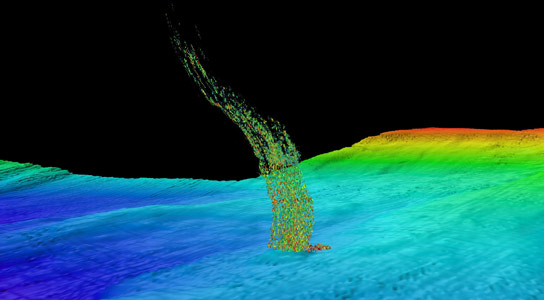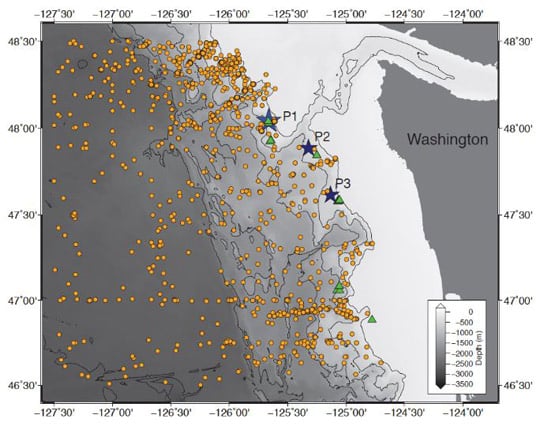
Sonar image of bubbles rising from the seafloor off the Washington coast. The base of the column is 1/3 of a mile (515 meters) deep and the top of the plume is at 1/10 of a mile (180 meters) deep. Credit: Brendan Philip / UW
A new study published in Geophysical Research Letters reveals that warmer Pacific Ocean temperatures could release millions of tons of seafloor methane.
Off the West Coast of the United States, methane gas is trapped in frozen layers below the seafloor. New research from the University of Washington shows that water at intermediate depths is warming enough to cause these carbon deposits to melt, releasing methane into the sediments and surrounding water.
Researchers found that water off the coast of Washington is gradually warming at a depth of 500 meters (1,640 feet), about a third of a mile down. That is the same depth where methane transforms from a solid to a gas. The research suggests that ocean warming could be triggering the release of a powerful greenhouse gas.
While scientists believe that global warming will release methane from gas hydrates worldwide, most of the current focus has been on deposits in the Arctic. This paper estimates that from 1970 to 2013, some 4 million metric tons of methane has been released from hydrate decomposition off Washington. That’s an amount each year equal to the methane from natural gas released in the 2010 Deepwater Horizon blowout off the coast of Louisiana, and 500 times the rate at which methane is naturally released from the seafloor.
“Methane hydrates are a very large and fragile reservoir of carbon that can be released if temperatures change,” Solomon said. “I was skeptical at first, but when we looked at the amounts, it’s significant.”
Methane is the main component of natural gas. At cold temperatures and high ocean pressure, it combines with water into a crystal called methane hydrate. The Pacific Northwest has unusually large deposits of methane hydrates because of its biologically productive waters and strong geologic activity. But coastlines around the world hold deposits that could be similarly vulnerable to warming.
“This is one of the first studies to look at the lower-latitude margin,” Solomon said. “We’re showing that intermediate-depth warming could be enhancing methane release.”
Co-author Una Miller, a UW oceanography undergraduate, first collected thousands of historic temperature measurements in a region off the Washington coast as part of a separate research project in the lab of co-author Paul Johnson, a UW professor of oceanography. The data revealed the unexpected sub-surface ocean warming signal.
“Even though the data was raw and pretty messy, we could see a trend,” Miller said. “It just popped out.”

The yellow dots show all the ocean temperature measurements off the Washington coast from 1970 to 2013. The green triangles are places where scientists and fishermen have seen columns of bubbles. The stars are where the UW researchers took more measurements to check whether the plumes are due to warming water. Credit: Una Miller / UW
The four decades of data show deeper water has, perhaps surprisingly, been warming the most due to climate change.
“A lot of the earlier studies focused on the surface because most of the data is there,” said co-author Susan Hautala, a UW associate professor of oceanography. “This depth turns out to be a sweet spot for detecting this trend.” The reason, she added, is that it lies below water nearer the surface that is influenced by long-term atmospheric cycles.
The warming water probably comes from the Sea of Okhotsk, between Russia and Japan, where surface water becomes very dense and then spreads east across the Pacific. The Sea of Okhotsk is known to have warmed over the past 50 years, and other studies have shown that the water takes a decade or two to cross the Pacific and reach the Washington coast.
“We began the collaboration when we realized this is also the most sensitive depth for methane hydrate deposits,” Hautala said. She believes the same ocean currents could be warming intermediate-depth waters from Northern California to Alaska, where frozen methane deposits are also known to exist.
Warming water causes the frozen edge of methane hydrate to move into deeper water. On land, as the air temperature warms on a frozen hillside, the snowline moves uphill. In a warming ocean, the boundary between frozen and gaseous methane would move deeper and farther offshore. Calculations in the paper show that since 1970 the Washington boundary has moved about 1 kilometer (0.6 miles) – a little more than a half-mile – farther offshore. By 2100, the boundary for solid methane would move another 1 to 3 kilometers (0.6 to 1.9 miles) out to sea.
Estimates for the future amount of gas released from hydrate dissociation this century are as high as 0.4 million metric tons per year off the Washington coast, or about quadruple the amount of methane from the Deepwater Horizon blowout each year.
Still unknown is where any released methane gas would end up. It could be consumed by bacteria in the seafloor sediment or in the water, where it could cause seawater in that area to become more acidic and oxygen-deprived. Some methane might also rise to the surface, where it would be released into the atmosphere as a greenhouse gas, compounding the effects of climate change.
Researchers now hope to verify the calculations with new measurements. For the past few years, curious fishermen have sent UW oceanographers sonar images showing mysterious columns of bubbles. Solomon and Johnson just returned from a cruise to check out some of those sites at depths where Solomon believes they could be caused by warming water.
“Those images the fishermen sent were 100 percent accurate,” Johnson said. “Without them, we would have been shooting in the dark.”
Johnson and Solomon are analyzing data from that cruise to pinpoint what’s triggering this seepage, and the fate of any released methane. The recent sightings of methane bubbles rising to the sea surface, the authors note, suggest that at least some of the seafloor gas may reach the surface and vent to the atmosphere.
Reference: “Dissociation of Cascadia margin gas hydrates in response to contemporary ocean warming” by Susan L. Hautala, Evan A. Solomon, H. Paul Johnson, Robert N. Harris and Una K. Miller, 4 November 2014, Geophysical Research Letters.
DOI: 10.1002/2014GL061606
The research was funded by the National Science Foundation and the U.S. Department of Energy. The other co-author is Robert Harris at Oregon State University.









More evidence supporting the predictions that the rate climate change will pick up speed in the coming decades especially if carbon emissions are not significantly reduced as the scientists say should be done.
So what do you suppose the government will want to tax over this one?
I would be more worried about the chickens that will come home to roost sooner or later from this one..
Based on water that has warmed 50 years ago. Before CO2 levels had drastically risen. Try another theory.
learn to read.. the water has warmed OVER (a timesspan of) 50 years and it takes 10-20 years to cross the ocean floor from Okhotsk to Washington.
And it’s not hard to stick a thermometer into water and note what it says over a couple of years.
Why doesn’t someone go out there and harvest the methane. By the way, man made has nothing to do with the temperature of the planet earth. Average temperature hasn’t risen in 17+ years while substantial amounts of CO2 has been pumped into the air. Wasting energy and wealth on foolish means of control.
> hasn’t risen
Says who? Why do you consider your source trustworthy?
Have you taken and passed Statistics 101, or if not, what’s your reasoning?
I trust this statistician, after looking hard at his work:
You should look hard at whoever’s work you’re relying on and saying who it is would give more than just ‘some guy on the Internet’ to follow up.
They have told us the ocean has warmed 0.1 degree. So our planet is soooo fragile that tenths of a degree cause catastrophe. How did we ever get out of the ice age to today’s virtual garden of eden?
> How did we ever get out of the ice age …?
Glad you asked.
1) Very slowly, due to changes in Earth’s orbit that caused warming.
How much? Here, picture:
From 20,000 to 8,000 years ago, warming to the end of the ice age, then the beginning of the typical slow cooling from about 8,000 years ago until we started burning coal. Since then, rapid warming. Very rapid. As much warming as the amount that slowly took us out of the Ice Age — very fast.
Hey, what could go wrong?
Dont tell us, do something about it!!!!
The worst scientists to have ever called themselves scientists are walking the Earth today and some of them have just published this paper. Only the scientifically illiterate fall for these scare mongering articles.
Not only is the Pacific Ocean itself actually not warming (it has cooled over the past 10 years), but the oceans as a whole have only warmed literally just a few hundredths of a degree. The completely fictional idea that deep ocean water is going to warm by a few degrees can only be described as insane.
any literate would have 1-2 sources linked for claims he makes in his post, so where are those time-series of the pacific temperatures that do go down over the last 10 years? Very questionable methods you use there my friend.
All I’m hearing from people who do the legwork (actual scientists) is that the temperatures of the oceans rise on average.
I also heard that atm they can’t explain where some of the energy got ‘parked at’ as they don’t seem to have enough warming in the ocean waters where they measure for it to make sense on a global scale, but that’s just another puzzle to solve I guess.
A million here, a million there, eventually enough millions would add up.
But — hat tip to Fractalplanet —
“For context, their “up to 0.4 million metric tons of methane” (of which none may reach the atmosphere) would be about 0.07% of the estimated annual global methane release.”
The recent findings of methane gas on Mars and evidence that Mars was having watery oceans or lakes once in its lifetime, may suggest the theory that millions and millions of methane gas is released from the ocean beds today. In Mars, the methane gas is still hanging over to suggest that sea plants and animals were there once and the methane gas is trapped even today in its atmosphere. Besides carbon-di-oxide atmosphere is an indication to suggest that organic past of the planet. Mars becoming red by iron is an indication of its inorganic past were every element is oxidized by using up the little oxygen in the atmosphere. Thank You.